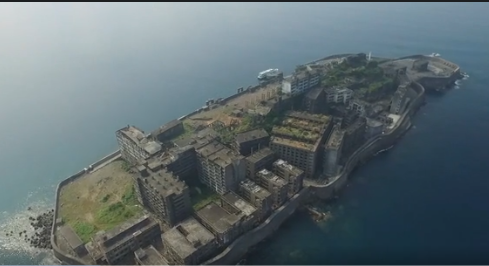Off the coast of Nagasaki, Japan lies one of the most striking and eerie relics of the modern industrial age—Hashima Island. Also known as Gunkanjima, or “Battleship Island” for its warship-like silhouette, Hashima was once a symbol of progress and prosperity. Today, it stands as a decaying monument frozen in time, its empty buildings and wind-worn concrete walls offering a silent glimpse into a lost world.
Thanks to stunning aerial footage captured by drones, global audiences can now explore the ghost town’s haunting geometry and melancholy grandeur without setting foot on its storm-battered shores. The island, which once thrived with coal miners and their families, has become a cinematic emblem of abandonment—and resilience.
A Legacy of Industry
Hashima Island was developed in the late 19th century by the Mitsubishi Corporation as a base for undersea coal mining. At its peak in the 1950s, it was one of the most densely populated places on Earth, with over 5,000 residents packed into the island’s limited footprint.
To accommodate the rapid growth, Mitsubishi constructed Japan’s first large-scale concrete apartment complexes. Rising vertically from the rocky terrain, these brutalist-style buildings became the island’s defining architectural feature. Schools, hospitals, shops, and even a cinema filled the narrow alleys between towers, creating a self-contained world at sea.
The Fall into Silence
With the decline of coal and the rise of petroleum in the late 20th century, Hashima’s mines became obsolete. In 1974, operations ceased, and the island was completely evacuated. What remains is a desolate skeleton of urban ambition, left to battle the forces of nature alone.
Rain and salt-laden wind have etched the buildings into ghostly ruins. Trees and moss now claim the staircases, windows, and floors once filled with life. The ocean, once a gateway for commerce, now pounds the shores with relentless waves, eroding what industry left behind.

Drone Footage Reveals a Lost City
Recent drone expeditions have allowed historians, documentarians, and curious viewers to witness Hashima like never before. Filming from above reveals symmetrical rows of concrete, broken rooftops, and empty corridors that snake through the cityscape.
Pop Culture Fame and UNESCO Recognition
Hashima’s haunting appearance has attracted global attention beyond academia. It served as the inspiration for the villain’s lair in the James Bond film Skyfall and has appeared in video games and documentaries. Despite its eerie silence, the island continues to speak through popular media.
In 2015, Hashima Island was designated as a UNESCO World Heritage Site, recognized as part of Japan’s Meiji Industrial Revolution. The designation acknowledged both the site’s historical significance and its role in Japan’s transition to modern industrial power.
Ethical and Historical Complexities
While the island’s aesthetic and historical allure is undeniable, it also carries a darker legacy. During World War II, conscripted laborers from Korea and China were forced to work in the harsh conditions of Hashima’s mines. Their suffering is an integral part of the island’s story—one that Japan has been urged to confront more openly in preservation efforts.
Tourism to the island remains regulated, with safety restrictions limiting where visitors can explore. Still, virtual tours and drone videos have allowed wider access and public reflection on both the brilliance and brutality of industrial expansion.
The Symbolism of Abandonment
Hashima is more than a ghost town; it is a mirror. It reflects humanity’s ceaseless pursuit of energy, prosperity, and progress—and the cost of moving too quickly, too densely, too boldly. The silence on Hashima is not empty; it is filled with echoes of ambition, struggle, and time.
In a world rushing to build the future, Hashima forces us to pause and consider what happens to places when they are no longer useful, and what stories survive when the people are gone.
Conclusion
As drone footage of Hashima Island continues to circulate globally, viewers are reminded that beauty and ruin often coexist. The island stands not just as a historical artifact, but as a haunting meditation on memory, industry, and impermanence. With every gust of sea wind that pushes through its hollow corridors, Hashima whispers a timeless truth: even the strongest walls cannot hold back time.

